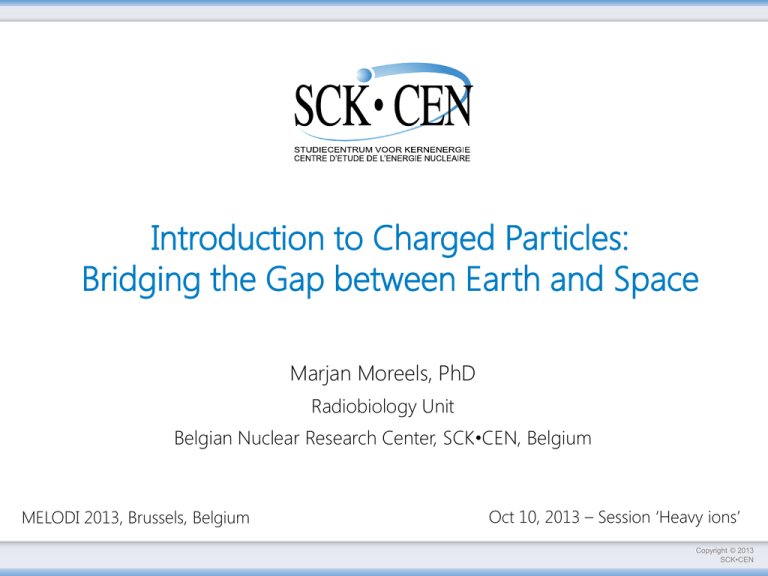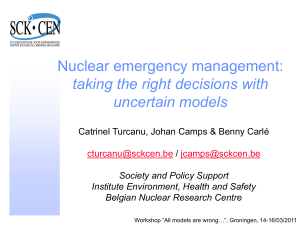Introduction to Charged Particles: Bridging the Gap
advertisement

Introduction to Charged Particles: Bridging the Gap between Earth and Space Marjan Moreels, PhD Radiobiology Unit Belgian Nuclear Research Center, SCK•CEN, Belgium MELODI 2013, Brussels, Belgium Oct 10, 2013 – Session ‘Heavy ions’ Copyright © 2013 SCK•CEN Sources of Radiation Exposure 2.4 mSv/yr WNA (2013) Different radiation qualities Low-energy particles (alpha, beta) Photons (γ-rays, X-rays) Copyright © 2013 SCK•CEN Exposure to high-energy charged particles 1. Natural Occupational activities in space 2. Man-made Cancer radiotherapy Copyright © 2013 SCK•CEN 1. Natural exposure to charged particles Dense ionization tracks (high RBE) Maalouf et al., J Rad Res 52 (2011) Main health risk for long-term space missions Copyright © 2013 SCK•CEN 2. Man-made exposure to charged particles Particle accelerators Proton Carbon (high RBE, OER) Copyright © 2013 SCK•CEN Conditions Space Particle therapy Source Particle Max Energy Dose Exposure Copyright © 2013 SCK•CEN Conditions Source Space Particle therapy Galaxy - Sun Particle accelerators Particle Max Energy Dose Exposure Copyright © 2013 SCK•CEN Conditions Space Particle therapy Source Galaxy - Sun Particle accelerators Particle All ions from H to Fe H and C (Li, O, …) Max Energy Dose Exposure Copyright © 2013 SCK•CEN Conditions Space Particle therapy Source Galaxy - Sun Particle accelerators Particle All ions from H to Fe H and C (Li, O, …) Max Energy ~10 GeV/n H: ~250 MeV/u C: ~400 MeV/u Dose Exposure Copyright © 2013 SCK•CEN Conditions Space Particle therapy Source Galaxy - Sun Particle accelerators Particle All ions from H to Fe H and C (Li, O, …) Max Energy ~10 GeV/n H: ~250 MeV/u C: ~400 MeV/u Dose - ISS: 200-600 µSv/day - Interplanetary: 1-2 mSv/day (GCR: low dose - SPE: high dose) - Round trip Mars: ~0.66 Sv - Target: high (60-80 Gy-eq) - Margin: high/low - Surrounding tissue: low (+problem of leakage neutrons!) (Zeitlin et al., Science 340 (2013)) Exposure Copyright © 2013 SCK•CEN Conditions Space Particle therapy Source Galaxy - Sun Particle accelerators Particle All ions from H to Fe H and C (Li, O, …) Max Energy ~10 GeV/n H: ~250 MeV/u C: ~400 MeV/u Dose - ISS: 200-600 µSv/day - Interplanetary: 1-2 mSv/day (GCR: low dose - SPE: high dose) - Round trip Mars: ~0,66 Sv - Target: high (60-80 Gy-eq) - Margin: high/low - Surrounding tissue: low (+problem of leakage neutrons!) Chronic Whole body Acute Partial body (Zeitlin et al., Science 340 (2013)) Exposure Copyright © 2013 SCK•CEN Current concerns and uncertainties about charged particles …in the low dose range 12 Copyright © 2013 SCK•CEN Carcinogenesis 13 Copyright © 2013 SCK•CEN Carcinogenesis risk in space Charged particles have a higher carcinogenic effect than low-LET Main risk factor for astronauts Large uncertainties in cancer risk prediction Durante & Cucinotta, Nature Rev 8 (2008) Copyright © 2013 SCK•CEN Secondary malignancies after particle therapy Long-term survivors of cancers after conventional RT 10-20% of secondary malignancies 30 yrs after treatment (Smith et al, J Clin Oncol 28 (2010); Friedman et al., J Natl Cancer Inst 102 (2010)) Risks following particle therapy have not been determined Cancers can arise in the irradiation field (high dose) or in distal organs (low-dose region) + (low dose) neutron leakage Need to develop risk assessment based on current knowledge of radiation-induced carcinogenesis Impact of age – genetic susceptibility – radiation quality Copyright © 2013 SCK•CEN Charged particle research @Radiobiology Unit of SCK•CEN 16 Copyright © 2013 SCK•CEN Particle Research at SCK•CEN Fundamental research into biological actions of charged particles In vitro studies (normal + cancer cells) Hadron therapy for prostate cancer ( ppt Annelies Suetens) Biodosimetry & individual radiosensitivity (ESA IBER-3 GYMBRASS) Toxicity of normal tissues (cardiovascular– immune system) Copyright © 2013 SCK•CEN Let’s get started now… Copyright © 2013 SCK•CEN Thank you for your attention! Copyright © 2013 SCK•CEN Copyright © 2013 - SCKCEN PLEASE NOTE! This presentation contains data, information and formats for dedicated use ONLY and may not be copied, distributed or cited without the explicit permission of the SCK•CEN. If this has been obtained, please reference it as a “personal communication. By courtesy of SCK•CEN”. SCK•CEN Studiecentrum voor Kernenergie Centre d'Etude de l'Energie Nucléaire Belgian Nuclear Research Centre Stichting van Openbaar Nut Fondation d'Utilité Publique Foundation of Public Utility Registered Office: Avenue Herrmann-Debrouxlaan 40 – BE-1160 BRUSSELS Operational Office: Boeretang 200 – BE-2400 MOL Copyright © 2013 SCK•CEN (Neuro)degenerative diseases 22 Copyright © 2013 SCK•CEN Neurodegenerative changes Light flash phenomenon Particle interaction with retinal photoreceptors Copyright © 2013 SCK•CEN




